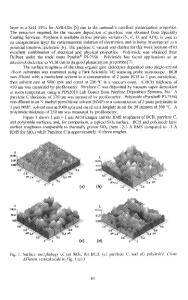Light Sensitive Polymer Thin Film Transistors Based on BAS-PPE
- PDF / 59,714 Bytes
- 5 Pages / 612 x 792 pts (letter) Page_size
- 119 Downloads / 314 Views
I13.7.1
Light Sensitive Polymer Thin Film Transistors Based on BAS-PPE Yifan Xu and Paul R. Berger a) Department of Electrical and Computer Engineering The Ohio State University, Columbus, OH 43210 USA James N. Wilson and Uwe H.F. Bunz School of Chemistry and Biochemistry Georgia Institute of Technology Atlanta, GA 30332 USA The photoresponse of polymer field effect transistors (PFETs) based on the 2,5bis(dibutylaminostyryl)-1,4-phenylene-b-alkyne-b-1,4-bis(2-ethylhexyl)benzene terpolymer (BAS-PPE) is investigated. BAS-PPE is a photoluminescent conducting polymer with a bandgap of 2.25 eV. The BAS-PPE PFETs were fabricated using an open coplanar configuration and light is illuminated onto the top side of the PFETs. A sweep of VDS demonstrates that IDS saturation is suppressed during illumination, which suggests that pinch-off can not be reached since the injection of photo-generated carriers continues unabated. Also, with incident light, the channel can not be turned off, even at high positive gate biases, due to the accumulation of photogenerated carriers. A sweep of VDS also shows that BAS-PPE can act as a p-type polymer and favors hole injection and transport. a)
Author to whom correspondence should be addressed. Also at: Department of Physics, Smith Laboratory, 174 W. 18th Avenue, Columbus, OH 43210; Electronic mail: [email protected] Introduction Conjugated polymers have shown great promise as polymer light emitting diodes (PLEDs) and polymer field effect transistors (PFETs) [1-7]. The highest occupied molecular orbital (HOMO) and lowest unoccupied molecular orbital (LUMO) levels of polymer semiconductors can be critical in building a working device because the energy barrier for charge injection is determined by the energy difference between the metal electrode and the HOMO and/or LUMO levels. Fortunately, the HOMO and LUMO properties of polymer semiconductors can be engineered by proper chemical synthesis. Polyphenyleneethynylene (PPE) derivatives are such a group of polymers whose bandgaps can be altered by changing the substitute side chains on the PPE main chain [8]. As the dehydrogenated congener of polyphenylenevinylen (PPV), PPE did not receive as much popularity in the early boost of semiconductor polymer research due to its low HOMO level. However, recently PPE derivatives have attracted more attention due to work on cross-conjugated polymers. The cross-conjugated PPE-PPV hybrids 2,5bis(dibutylaminostyryl)-1,4-phenylene-b-alkyne-b-1,4-bis(2-ethylhexyl)benzene terpolymer (BAS-PPE) demonstrate the combined advantages of both PPV and PPE (Fig. 1). PPEs feature a triple instead of double bond in the conjugated backbone. The electron withdrawing nature of the alkyne groups determines that hole injection into PPE is subject to a higher energy barrier than electron injection [8-9]. The styryl side chains are laterally attached to the benzene rings in the PPE backbone. The bulky nature of the styryl side chains prevents conformational order in BASPPE, so this polymer is amorphous and has broad absorption/emi
Data Loading...









